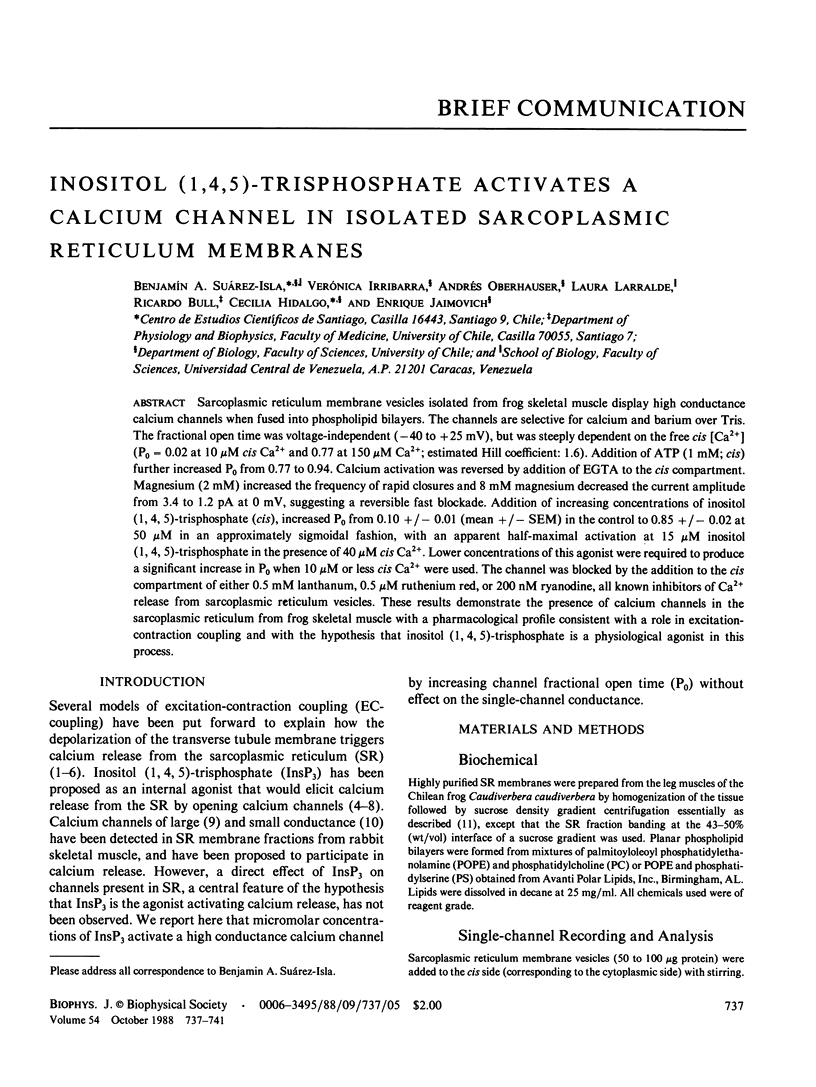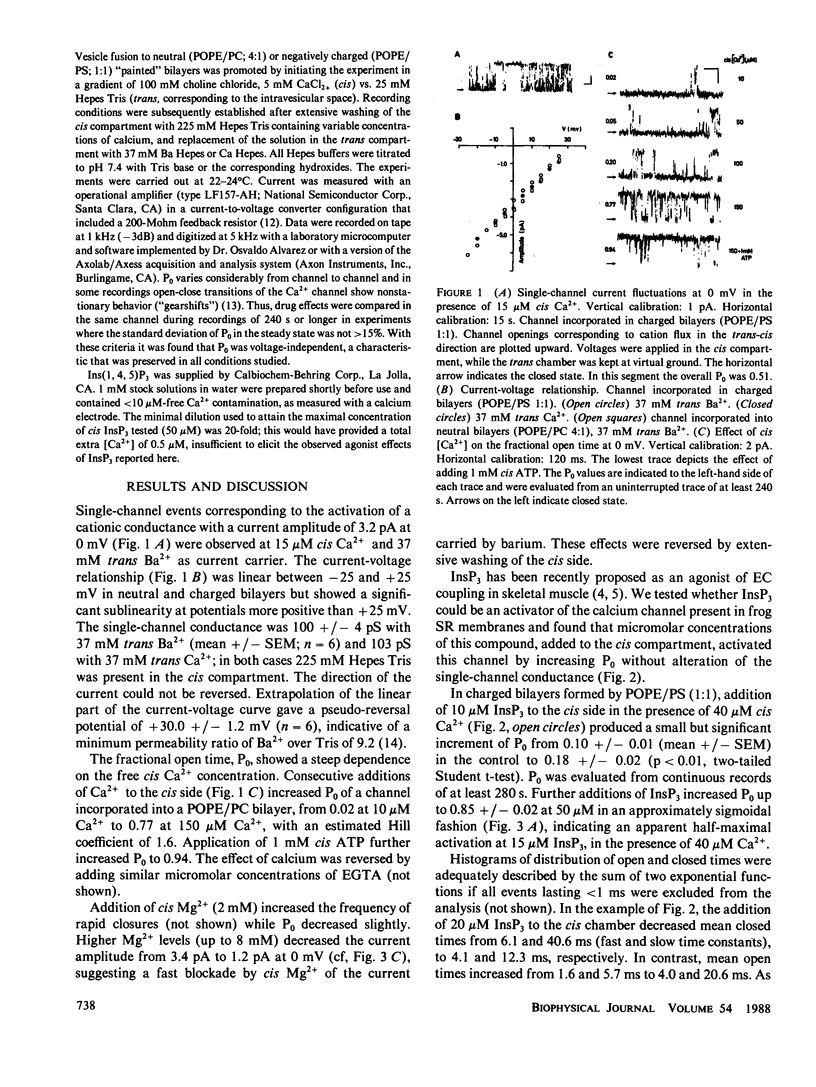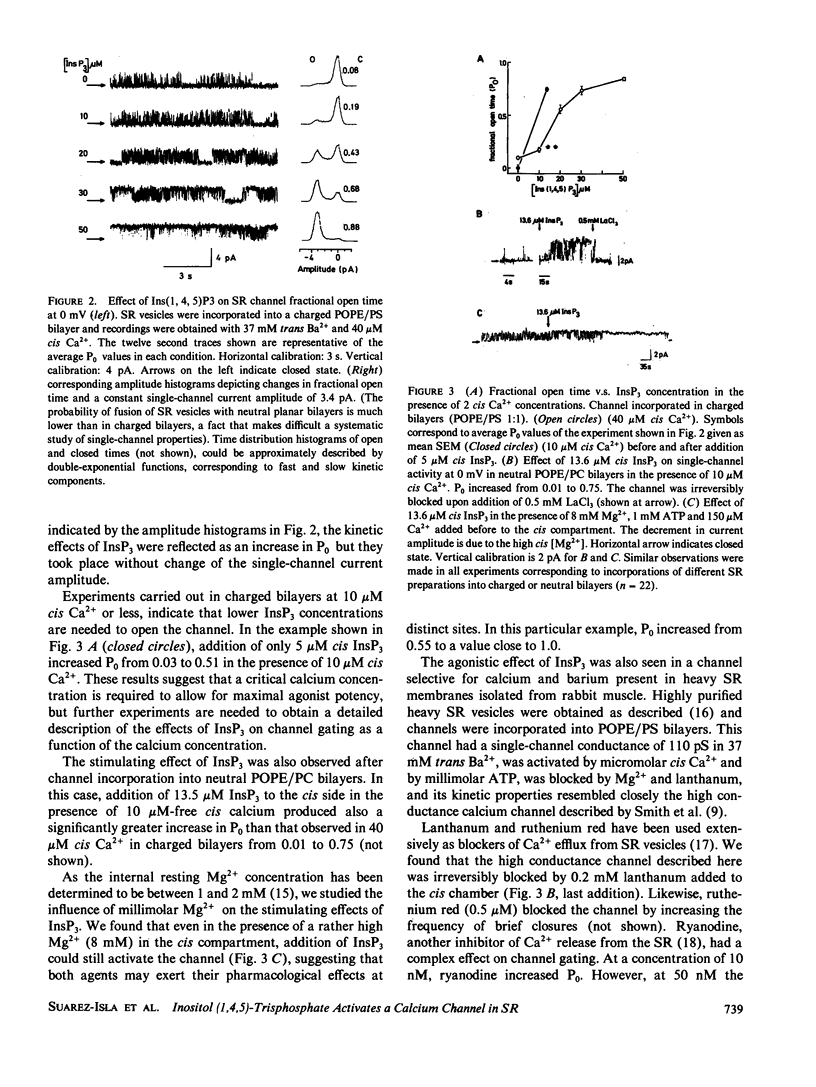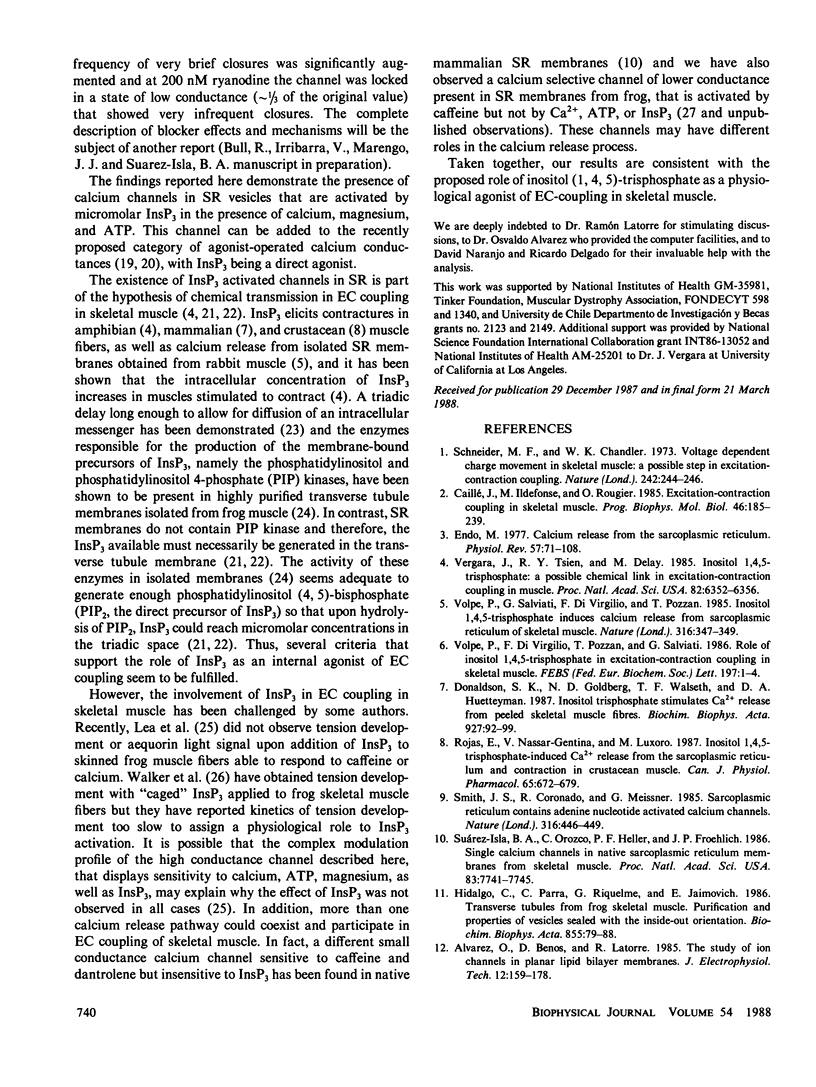Abstract
Sarcoplasmic reticulum membrane vesicles isolated from frog skeletal muscle display high conductance calcium channels when fused into phospholipid bilayers. The channels are selective for calcium and barium over Tris. The fractional open time was voltage-independent (-40 to +25 mV), but was steeply dependent on the free cis [Ca2+] (P0 = 0.02 at 10 microM cis Ca2+ and 0.77 at 150 microM Ca2+; estimated Hill coefficient: 1.6). Addition of ATP (1 mM; cis) further increased P0 from 0.77 to 0.94. Calcium activation was reversed by addition of EGTA to the cis compartment. Magnesium (2 mM) increased the frequency of rapid closures and 8 mM magnesium decreased the current amplitude from 3.4 to 1.2 pA at 0 mV, suggesting a reversible fast blockade. Addition of increasing concentrations of inositol (1, 4, 5)-triphosphate (cis), increased P0 from 0.10 +/- 0.01 (mean +/- SEM) in the control to 0.85 +/- 0.02 at 50 microM in an approximately sigmoidal fashion, with an apparent half-maximal activation at 15 microM inositol (1, 4, 5)-trisphosphate in the presence of 40 microM cis Ca2+. Lower concentrations of this agonist were required to produce a significant increase in P0 when 10 microM or less cis Ca2+ were used. The channel was blocked by the addition to the cis compartment of either 0.5 mM lanthanum, 0.5 microM ruthenium red, or 200 nM ryanodine, all known inhibitors of Ca2+ release from sarcoplasmic reticulum vesicles. These results demonstrate the presence of calcium channels in the sarcoplasmic reticulum from frog skeletal muscle with a pharmacological profile consistent with a role in excitation contraction coupling and with the hypothesis that inositol ( 1,4,5)-trisphosphate is a physiological agonist in this process.
Full text
PDF




Selected References
These references are in PubMed. This may not be the complete list of references from this article.
- Alvarez-Leefmans F. J., Gamiño S. M., Giraldez F., González-Serratos H. Intracellular free magnesium in frog skeletal muscle fibres measured with ion-selective micro-electrodes. J Physiol. 1986 Sep;378:461–483. doi: 10.1113/jphysiol.1986.sp016230. [DOI] [PMC free article] [PubMed] [Google Scholar]
- Benham C. D., Tsien R. W. A novel receptor-operated Ca2+-permeable channel activated by ATP in smooth muscle. Nature. 1987 Jul 16;328(6127):275–278. doi: 10.1038/328275a0. [DOI] [PubMed] [Google Scholar]
- Caillé J., Ildefonse M., Rougier O. Excitation-contraction coupling in skeletal muscle. Prog Biophys Mol Biol. 1985;46(3):185–239. doi: 10.1016/0079-6107(85)90009-4. [DOI] [PubMed] [Google Scholar]
- Donaldson S. K., Goldberg N. D., Walseth T. F., Huetteman D. A. Inositol trisphosphate stimulates calcium release from peeled skeletal muscle fibers. Biochim Biophys Acta. 1987 Jan 19;927(1):92–99. doi: 10.1016/0167-4889(87)90070-x. [DOI] [PubMed] [Google Scholar]
- Endo M. Calcium release from the sarcoplasmic reticulum. Physiol Rev. 1977 Jan;57(1):71–108. doi: 10.1152/physrev.1977.57.1.71. [DOI] [PubMed] [Google Scholar]
- FATT P., GINSBORG B. L. The ionic requirements for the production of action potentials in crustacean muscle fibres. J Physiol. 1958 Aug 6;142(3):516–543. doi: 10.1113/jphysiol.1958.sp006034. [DOI] [PMC free article] [PubMed] [Google Scholar]
- Hidalgo C., Carrasco M. A., Magendzo K., Jaimovich E. Phosphorylation of phosphatidylinositol by transverse tubule vesicles and its possible role in excitation-contraction coupling. FEBS Lett. 1986 Jun 23;202(1):69–73. doi: 10.1016/0014-5793(86)80651-2. [DOI] [PubMed] [Google Scholar]
- Hidalgo C., Parra C., Riquelme G., Jaimovich E. Transverse tubules from frog skeletal muscle. Purification and properties of vesicles sealed with the inside-out orientation. Biochim Biophys Acta. 1986 Feb 13;855(1):79–88. doi: 10.1016/0005-2736(86)90191-4. [DOI] [PubMed] [Google Scholar]
- Kuno M., Gardner P. Ion channels activated by inositol 1,4,5-trisphosphate in plasma membrane of human T-lymphocytes. Nature. 1987 Mar 19;326(6110):301–304. doi: 10.1038/326301a0. [DOI] [PubMed] [Google Scholar]
- Lea T. J., Griffiths P. J., Tregear R. T., Ashley C. C. An examination of the ability of inositol 1,4,5-trisphosphate to induce calcium release and tension development in skinned skeletal muscle fibres of frog and crustacea. FEBS Lett. 1986 Oct 20;207(1):153–161. doi: 10.1016/0014-5793(86)80031-x. [DOI] [PubMed] [Google Scholar]
- Meissner G. Adenine nucleotide stimulation of Ca2+-induced Ca2+ release in sarcoplasmic reticulum. J Biol Chem. 1984 Feb 25;259(4):2365–2374. [PubMed] [Google Scholar]
- Moczydlowski E., Latorre R. Gating kinetics of Ca2+-activated K+ channels from rat muscle incorporated into planar lipid bilayers. Evidence for two voltage-dependent Ca2+ binding reactions. J Gen Physiol. 1983 Oct;82(4):511–542. doi: 10.1085/jgp.82.4.511. [DOI] [PMC free article] [PubMed] [Google Scholar]
- Rojas E., Nassar-Gentina V., Luxoro M., Pollard M. E., Carrasco M. A. Inositol 1,4,5-trisphosphate-induced Ca2+ release from the sarcoplasmic reticulum and contraction in crustacean muscle. Can J Physiol Pharmacol. 1987 Apr;65(4):672–680. doi: 10.1139/y87-111. [DOI] [PubMed] [Google Scholar]
- Rosemblatt M., Hidalgo C., Vergara C., Ikemoto N. Immunological and biochemical properties of transverse tubule membranes isolated from rabbit skeletal muscle. J Biol Chem. 1981 Aug 10;256(15):8140–8148. [PubMed] [Google Scholar]
- Schneider M. F., Chandler W. K. Voltage dependent charge movement of skeletal muscle: a possible step in excitation-contraction coupling. Nature. 1973 Mar 23;242(5395):244–246. doi: 10.1038/242244a0. [DOI] [PubMed] [Google Scholar]
- Smith J. S., Coronado R., Meissner G. Sarcoplasmic reticulum contains adenine nucleotide-activated calcium channels. Nature. 1985 Aug 1;316(6027):446–449. doi: 10.1038/316446a0. [DOI] [PubMed] [Google Scholar]
- Suarez-Isla B. A., Orozco C., Heller P. F., Froehlich J. P. Single calcium channels in native sarcoplasmic reticulum membranes from skeletal muscle. Proc Natl Acad Sci U S A. 1986 Oct;83(20):7741–7745. doi: 10.1073/pnas.83.20.7741. [DOI] [PMC free article] [PubMed] [Google Scholar]
- Sutko J. L., Ito K., Kenyon J. L. Ryanodine: a modifier of sarcoplasmic reticulum calcium release in striated muscle. Fed Proc. 1985 Dec;44(15):2984–2988. [PubMed] [Google Scholar]
- Vergara J., Asotra K., Delay M. A chemical link in excitation-contraction coupling in skeletal muscle. Soc Gen Physiol Ser. 1987;42:133–151. [PubMed] [Google Scholar]
- Vergara J., Tsien R. Y., Delay M. Inositol 1,4,5-trisphosphate: a possible chemical link in excitation-contraction coupling in muscle. Proc Natl Acad Sci U S A. 1985 Sep;82(18):6352–6356. doi: 10.1073/pnas.82.18.6352. [DOI] [PMC free article] [PubMed] [Google Scholar]
- Volpe P., Salviati G., Di Virgilio F., Pozzan T. Inositol 1,4,5-trisphosphate induces calcium release from sarcoplasmic reticulum of skeletal muscle. Nature. 1985 Jul 25;316(6026):347–349. doi: 10.1038/316347a0. [DOI] [PubMed] [Google Scholar]
- Walker J. W., Somlyo A. V., Goldman Y. E., Somlyo A. P., Trentham D. R. Kinetics of smooth and skeletal muscle activation by laser pulse photolysis of caged inositol 1,4,5-trisphosphate. Nature. 1987 May 21;327(6119):249–252. doi: 10.1038/327249a0. [DOI] [PubMed] [Google Scholar]


